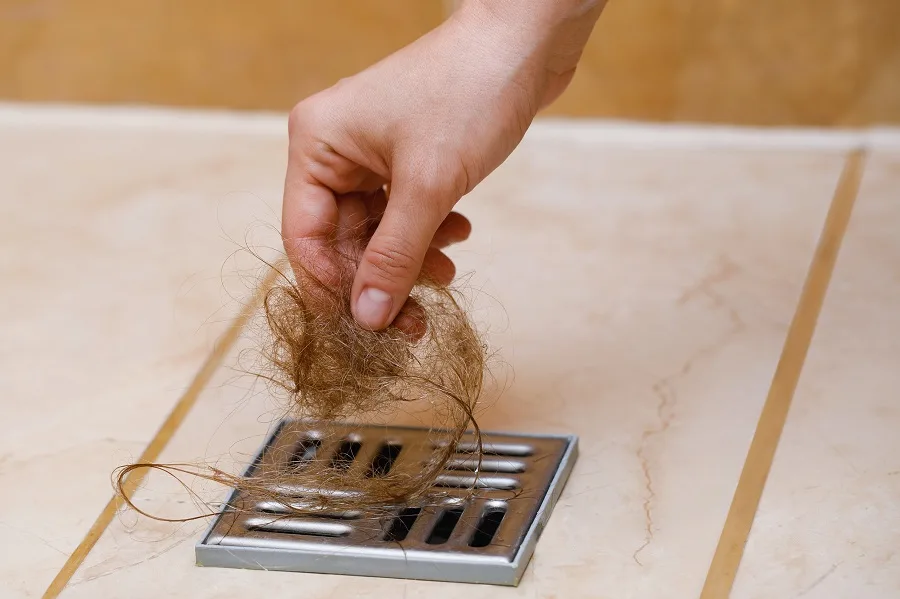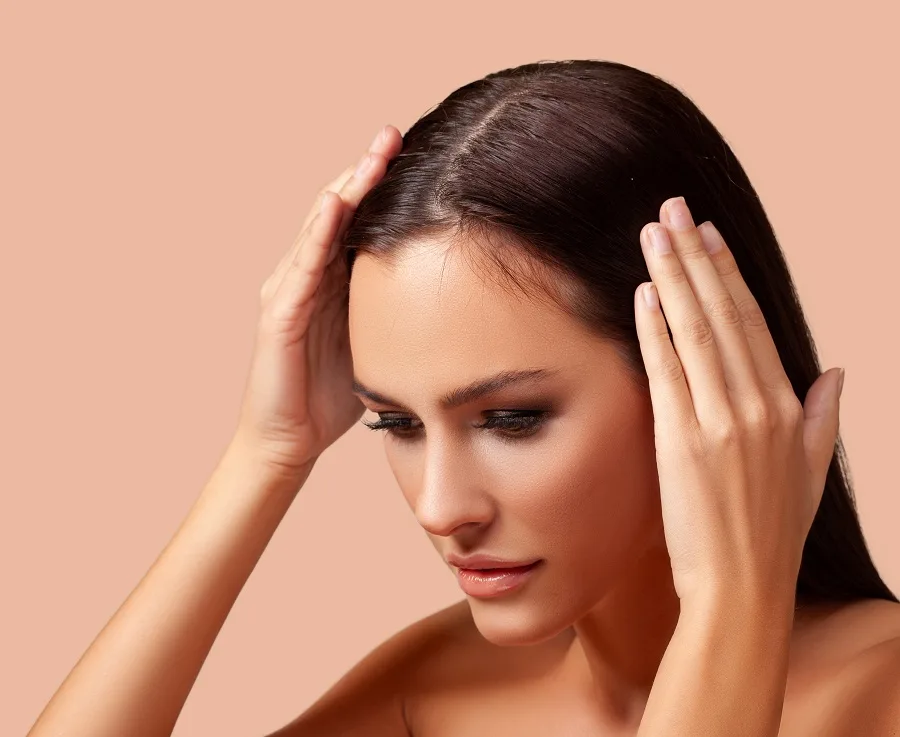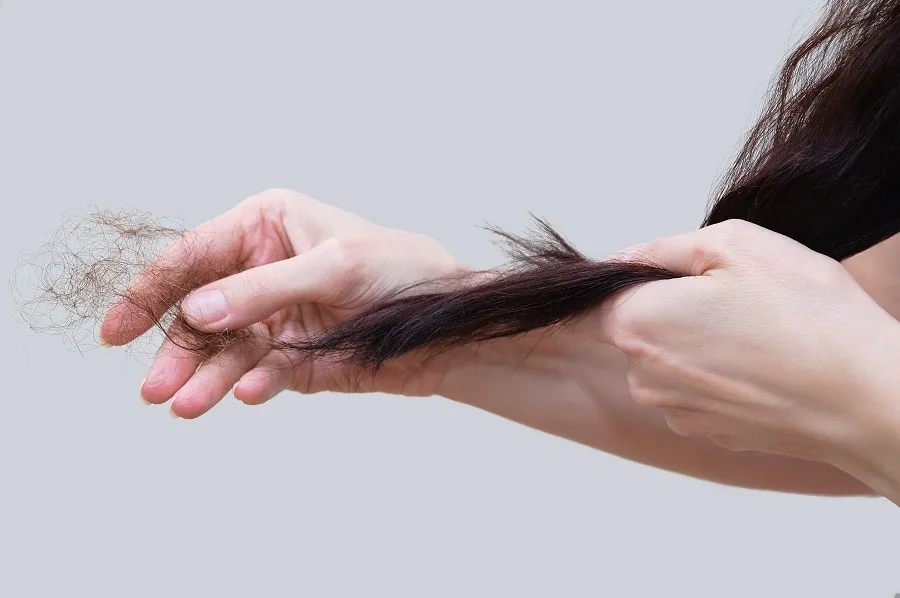Excessive hair fall is an emotional and stressful experience most adults deal with in their lifetime. When this happens, you may wonder, “Why am I losing too much hair?”
While it’s normal for your hair to fall out to some extent, too much signifies a problem. The following sections discuss various signs that you’re losing a lot of hair as well as the causes of excessive hair loss.
Key Takeaways
If you’re experiencing excessive hair loss, there are some warning signs to look for so you know when to seek professional assistance. Look for any of the following signs:
- Too much hair on your shower floor
- Lots of hair in your comb or brush
- Clumps of hair on your pillow
- Patchy bald spots
- Broadening hairline
- Thinner ponytail
- More hair falls after a 60-second hair count test
- Lots of hair fall out every time you run your hands through it
- A more noticeable scalp
- Slow or stunted hair growth
- Changes in hair texture or quality
- An increase in hair breakage or split ends
How Much Hair Loss Is Considered Normal?

It’s normal for people to lose 50 to 100 hair strands a day. This is a natural process where the hair goes through a regular renewal cycle. As you lose those hair strands, new ones grow to ensure you have healthier, fuller-looking hair.
A healthy scalp has between 100,000 and 150,000 hairs. If you lose 50-100 hair strands and grow more daily, you’ll barely notice your hair falling. Hair loss should cause worry if your scalp doesn’t replace the lost hair.
Fortunately, you can arrest hair fall if you notice signs of excessive falling earlier. So, how can you tell that you’re losing a lot of hair?
Major Signs That You Are Losing too Much Hair
According to dermatologists at NYU Langone Health, over 80% of men experience significant hair fall in their lifetime.
This contrasts with about 40–50% of women who deal with the same problem. The following signs can help you tell if you’re experiencing excessive hair loss:
Too Much Hair on Your Shower Floor

Too much hair on the shower floor is one of the most common signs of significant hair loss.
You’ll often see hair strands on your shower floor and drain after a shower. This occurrence is normal, especially for people with long hair.
But when you notice too much hair on the floor or the shower drain, that’s a sign you’re experiencing excessive hair fall. Pay attention to how often you lose clumps of hair after showering. If it occurs constantly, you may want to seek help.
Lots of Hair in Your Comb or Brush

A comb detangles your wet hair, while a brush comes in handy when massaging the scalp or removing dandruff. When combing or brushing your hair, it’s normal to see a few hairs gather in the comb or brush.
However, if your brush or comb collects a lot of hair, that’s a sign of excessive hair fall. You’ll notice this problem every time you comb or brush your hair.
Ensure your comb or brush is clean before starting. This will help you assess the number of hair strands you lose and determine if you need your doctor’s attention.
Clumps of Hair on Your Pillow
Do you sleep on a cotton pillowcase and see a few hair strands on the pillow every morning? Don’t worry because cotton pillowcases tend to damage long hair. They absorb moisture from your hair and twist it, causing it to break down.
You can address this problem by sleeping on a silk pillowcase. But what if you still find more hair on the pillow each morning? If the amount of hair on your pillow seems more than usual, you may be experiencing excessive hair fall.
Before you visit your dermatologist, ensure the fabric you’re sleeping on is not the cause of hair loss. You’ll also want to ensure the hair fall is not temporary, especially if you’ve undergone surgery or childbirth.
Patchy Bald Spots
Patchy bald spots on your scalp indicate greater than normal hair loss. This hair loss occurs in irregular or circular patches and is often called alopecia areata. You may see these patches at the crown if you have this problem.
Before developing patchy bald spots, you may experience an itchy or painful scalp. Patchy bald spots are more common in the US, affecting approximately 6.8 million people. The patches are usually few, but they may take over the broader part of your scalp.
Broadening Hairline

A widening hairline is one of the signs women notice they’re losing a lot of hair. This line runs through the scalp’s middle section from the forehead to the back.
If you have a broadening hairline, your scalp is more visible along that line that parts your hair. You’ll often see this line when brushing your hair.
Thinner Ponytail
If you have a ponytail that doesn’t feel as thick as before, you may be experiencing significant hair fall. Most people with ponytails won’t notice this problem until they detect a drastic difference.
The best way to determine if you have a thinner ponytail is by feeling it in your hands. Alternatively, use a hairband to tie the ponytail and check how many turns it takes to tie it up. If it takes more turns than before, your ponytail is thinner, and you might be losing too much hair.
More Hair Falls After a 60-Second Hair Count Test
The 60-second hair count test is another way you can tell if you’re losing too much hair. You’ll need to brush your hair for one minute in this test. Ensure to move the brush from back to front. After one minute, count the number of hair strands that fall.
If you count ten or fewer hair strands, you have a regular hair fall. More than ten hair strands indicate you’re losing too much hair.
Lots of Hair Falls Out Every Time You Run Your Hands Through It

This is another test you can use to determine if you’ve lost lots of hair. For reliable results, perform the test when your hair is not tangled. If only a few strands fall out after running the fingers through, you have nothing to worry about.
However, if you come out with a lot of hair, visit your doctor to determine if you’re experiencing significant hair loss.
A More Noticeable Scalp
Seeing a bit of the scalp through your hair should not be a cause for worry. This may happen depending on the hair’s texture. But if you see more scalp than your hair, that might signify excessive hair fall.
Most people’s follicles seem wide apart, and it’s easier to see into the scalp even if they have longer hair.
Slow or Stunted Hair Growth
Typical hair growth is half an inch per month. If your hair is growing less than that or seems thin and dull, you might be losing hair.
The two most common causes of slow hair growth are a hormonal imbalance (like hyperthyroidism) and not enough protein in your diet.
Hyperthyroidism is a common condition where your thyroid gland is either producing too much or not enough hormones.
Changes in Hair Texture or Quality
Healthy hair feels soft and smooth and looks shiny. If your hair is looking a little dull and feeling frizzy or dry, bring it back to life with a monthly hair mask and lay off the heat styling products.
This will give your hair a chance to grow back stronger and healthier. You can also make a point of massaging your scalp when you wash your hair to stimulate the distribution of the hair’s natural oils.
An Increase in Hair Breakage or Split Ends

Most of us know that split ends and hair breakage are signs that your hair isn’t healthy. When hair doesn’t get enough moisture, it breaks.
You can tell that your hair is breaking if you see more frizz than normal, if it feels brittle, or if you see lots of little pieces of hair either in your comb or when you’re styling it, and you see lots of shedding. Use moisturizing hair products to give your hair a health boost.
What Causes Excessive Hair Fall?

Why am I losing so much hair? Below are the causes of losing too much hair.
- Hereditary: Hair loss associated with inherited genes in your family is called androgenic alopecia. This hair fall comes with aging and follows a predictable pattern. If your relatives lose hair as they age, you will likely lose yours with time.
- Tight Hairstyles: High ponytails, tight braids, buns, or cornrows can stress your hair and cause it to fall.
- Health Conditions: Excessive hair fall may result from hormonal imbalance, psoriasis, scalp infections, and trichotillomania.
- Severe stress: If you’ve been through a long stressful period, you may start to experience excessive hair fall. The good news is this problem is temporary.
- Nutritional deficiency: If your diet is low in iron and protein over an extended period, you’re more prone to hair fall.
- Medications: Drugs used to treat conditions such as arthritis, cancer, heart problems, high blood pressure, depression, and gout can cause hair fall.
- Childbirth: Estrogen levels after delivery can decrease and cause hair fall in some women. Thankfully, this is a temporary hair fall.
So, How Do You Know You Are Losing too Much Hair?
There are several ways to know if you’re experiencing excessive hair fall. Look for any of the above signs – too much hair on your shower floor, comb or brush and on your pillow, patchy bald spots or visible scalp, bigger hairline, change in texture or color, etc.
FAQs
Vitamins that can reduce hair loss include iron, zinc, biotin, vitamin C, and vitamin D.
No. Hair loss occurs when a condition stops your hair from growing. On the other hand, hair shedding is normal, where your scalp sheds about 50-100 hairs a day.
No! Losing 300 hairs a day is abnormal. Normal hair loss is between 50 and 100 hair strands daily.
You should consult doctors if you experience one or some of the following signs of hair fall:
-Sudden hair fall
-Hair fall that comes with itching, pain, or redness
-Hair fall related to medication
-Excessive hair fall for an extended period
-Hair falls with symptoms like fatigue, muscle ache, heavy menstrual bleeding, or swollen lymph nodes.
-Hair fall resulting from medical conditions such as lupus and ringworm infections.
Recommended For You:
